Chapter: 10th Social Science : History : Chapter 1 : Outbreak of World War I and Its Aftermath
Causes, Course and Results of World War I
Causes, Course and Results of
World War I
(a) Causes
European Alliances and Counter-Alliances
In 1900
five of the European Great Powers were divided into two armed camps. One camp
consisted of the Central Powers-Germany, Austria-Hungary and Italy. Under the
guidance of Bismarck, they had formed the Triple Alliance in 1882. The
understanding was that Germany and Austria would help each other. The other
camp consisted of France and Russia. Their alliance was formed in 1894 with the
promise of mutual help if Germany attacked either of them. An isolated Britain
wanted to break her isolation and approached Germany twice but in vain. As
Japan was increasingly hostile towards Russia, as France was the ally of
Russia, it preferred to ally with Britain (1902). The Anglo-Japanese Alliance
prompted France to seek an alliance with Britain to resolve colonial disputes
over Morocco and Egypt. This resulted in the Entente Cordiale (1904). In return
for letting the French have a free hand in Morocco, France agreed to recognize
the British occupation of Egypt. Britain subsequently reached an agreement with
Russia over Persia, Afghanistan and Tibet.
Thus was
formed the Triple Entente of Britain, France and Russia.
Violent Forms of Nationalism
With the
growth of nationalism, the attitude of “my country right or wrong I support it”
developed. The love for one country demanded hatred for another country.
England’s jingoism, France’s chauvinism and Germany’s Kultur were militant
forms of nationalism, contributing decisively to the outbreak of War.
Aggressive Attitude of German Emperor
Emperor
Kaiser Wilhelm II of Germany proclaimed that Germany would be the leader of the
world. The German navy was expanded. The sea being considered a preserve of
England ever since Napoleon’s defeat at Trafalgar (1805), Germany’s aggressive
diplomacy and rapid building of naval bases convinced Britain that a German
navy could be directed only against her. Therefore, Britain embarked on a naval
race, which heightened the tension between the two powers.
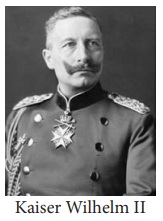
Hostility of France towards Germany
France
and Germany were old rivals. Bitter memories of the defeat of 1871 and loss of
Alsace and Lorraine to Germany rankled in the minds of the French. German
interference in Morocco added to the bitterness. The British agreement with
France over Morocco was not consented by Germany. So Kaiser Wilhelm II intentionally
recognised the independence of the Sultan and demanded an international
conference to decide on the future of Morocco.
Imperial Power Politics in the Balkans
The Young
Turk Revolution of 1908, an attempt at creating a strong and modern government
in Turkey, provided both Austria and Russia with the opportunity to resume
their activities in the Balkans. Austria and Russia met and agreed that Austria
should annexe Bosnia and Herzegovina, while Russia should have freedom to move
her warships, through the Dardanelles and the Bosporus, to the Mediterranean.
Soon after this, Austria announced the annexation of Bosnia and Herzegovina.
Austria’s action aroused intense opposition from Serbia. Germany gave Austria
firm support. Germany went to the extent of promising that if Austria invaded
Serbia and in consequence Russia helped Serbia, Germany would come to Austria’s
assistance. The enmity between Austria and Serbia led to the outbreak of war in
1914.
The Balkan Wars
Turkey
was a powerful country in the south west of Europe in the first half of
eighteenth century. The Ottoman empire extended over the Balkans and across
Hungary to Poland. The Empire contained many non-Turkish people in the Balkans.
Both the Turks and their subjects of different nationalities in the Balkans
indulged in the most frightful massacres and atrocities. The Armenian genocide
is a frightful example.
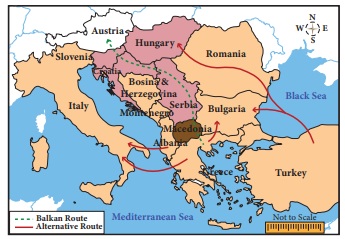
Taking
advantage of the political and economic instability of the Turkish Empire from
the second half of the eighteenth century, Greeks followed by others began to
secede, one after another, from Turkish control. Macedonia had a mixed
population. There were rivalries among Greece, Serbia, Bulgaria and later
Montenegro for the control of it. In March 1912 they formed the Balkan League.
The League attacked and defeated Turkish forces in the first Balkan War (1912–13).
According to the Treaty of London signed in May 1913 the new state of Albania
was created and the other Balkan states divided up Macedonia between them.
Turkey was reduced to the area around Constantinople.
The
division of Macedonia, however, did not satisfy Bulgaria. Bulgaria attacked
Serbia and Greece. But Bulgaria was easily defeated. The Second Balkan War
ended with the signing of the Treaty of Bucharest in August 1913.
Immediate Cause
The
climax to these events in the Balkans occurred in Sarajevo in Bosnia. On 28
June 1914 the Archduke Franz Ferdinand, heir to Franz Joseph, Emperor of
Austria-Hungary, was assassinated by Princip, a Bosnian Serb. Austria saw in
this an opportunity to eliminate Serbia as an independent state. Germany
thought that it should strike first. It declared war on Russia on 1 August.
Germany had no quarrel with France, but because of the Franco-Russian Alliance,
the German army which was planning a war against both France and Russia wanted
to use the occasion to its advantage. The German violation of Belgian
neutrality forced Britain to enter War.
(b) Course of the War
Two Warring Camps Central Powers
The
warring nations were divided into two. The Central powers consisted of Germany,
Austria–Hungary, Turkey and Bulgaria. Italy which was earlier with Germany and
Austria had left, as her attempt to recover Trentino in north east Italy, where
Italians lived in majority but remained as part and parcel of Austria-Hungary,
was not supported by Germany. Italy remained a neutral country when the War
broke out. But it decided to enter the War hoping to gain the territory in the
north - east. Britain, France and Italy signed the secret Treaty of London in
April 1915, by which Italy agreed to enter the War against the Central Powers
in return for this territory after the War.
Allies
Nine
states that opposed the Central powers were: Russia, France, Britain, Italy,
the United States, Belgium, Serbia, Romania and Greece. Romania and Greece
declared war on the Central Powers in 1916 and 1917 respectively but played
little part in the war. Most Americans wanted their country to remain neutral
and so in the first three years the United States gave only moral support and
valuable material aid to Britain and France.
Tsar’s Abortive Attempts for Peace
Tsar
Nicholas II of Russia suggested to the Powers that they meet together to bring
about an era of universal peace. In response, two Peace Conferences were held
at The Hague in Holland in 1899 and 1907 but in vain.
War in Western or French Front
Germany
steamrolled and smashed the resistance of the people of Belgium. On the side of
the Allies, the burden of the fighting fell on the French army. Within a month
Paris seemed almost doomed.
Battles of Tannenberg and Marne
Meanwhile
Russian forces invaded East Prussia. Germany defeated them decisively. At the
Battle of the Marne (early September 1914), the French succeeded in pushing
back the Germans. Paris was thus saved. The battle of Marne is a memorable for trench warfare.

Trench Warfare: Trenches or ditches dug by
troops enabled soldiers to safely stand and protect themselves from enemy
fire. The main lines of trenches were connected to each other and to the rear
by a series of linking trenches through which food, ammunition, fresh troops,
mail, and orders were delivered.
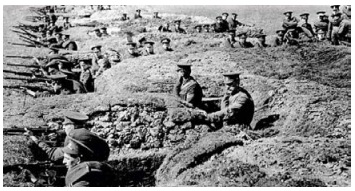
Battle of Verdun
Between
February and July 1916, the Germans attacked Verdun, the famous fortress in the
French line. In the five-month Battle of Verdun two million men took part and
half of them were killed. The British offensive against Germans occurred near
the River Somme. In this four-month Battle of Somme Britain lost 20,000 men on
the first day. The battle of Verdun, however, decided the fortunes of the War
in favour of the Allies.
War in Eastern or Russian front
In the
eastern front, Russian troops repeatedly defeated the Austrians. But the
Russians were in turn defeated by the Germans. Russia had the worst trained and
equipped army and therefore Russian losses were the greatest. In 1917, the
Tsarist regime in Russia was overthrown in a revolution. Russia wanted peace
and consequently it signed the Treaty of Brest-Litovsk (3 March 1918) with
Germany.
Minor Theatres of War In the Middle East
Turkey
also fought on the side of the central powers.Though Turkey met with initial
success and the Allies suffered reverses, particularly in Mesopotamia and
Gallipoli, ultimately Turkey was defeated.The Turks tried to attack Suez Canal,
but were repulsed. Britain attacked Turkey in Iraq, and later in Palestine and
Syria.
In the Far East
China
also joined the allies. Japan was able to capture the province of Kiauchau
given by the Germans to China in the province of Shantung. There was no war in
the Far East. Japan made use of the occasion to threaten China into ceding valuable
concessions and privileges.
In the Balkans
The
Austro-German army in coordination with Bulgaria crushed Serbia. Serbia came
under German rule. Rumania watched the course of the War and in August 1916
joined the Allies. Rumania also passed under Austro-German occupation.
Fate of Colonies of Germany in Africa
The
German colonies in western and eastern Africa were also attacked by the Allies.
As these colonies were quite far from Germany they could not receive any
immediate help, and therefore surrendered to the Allies.
Italy falls to Austrian onslaught
Italy
formally joined the Allies in the war in May 1916. Italians were fighting with
the Austrians and continued to sustain their resistance. But when the Germans
came to Austria’s help, the Italians collapsed.
Central Powers’ Victories
The
Central Powers successfully occupied Belgium and a part of France in the
north-east, Poland, Serbia and Romania.
The
epicentre of the struggle was the western front and the seas. As the Allies
controlled the sea-routes, they cut off the supply of food and other material
reaching the Central Powers. In Germany and Austria women and children suffered
from hunger and privation. Germany attacked England by air. Bombs were thrown
on London and places where there were major factories. Later aeroplanes were
used for targeting civilian population. The Germans introduced poison gas and
soon both sides resorted to its use.
Naval Battles and America’s Entry into the War
In 1916 a
naval battle (Battle of Jutland) had
taken place in the North Sea. The British won the battle. Thereafter Germany
started their submarine warfare and their cruisers went roaming about,
interfering with the shipping of the Allies. One of these was the famous Emden,
which bombarded Madras. As a counter measure to the blockade the Germans
proclaimed in January 1917 that they would sink even neutral ships in certain
waters. Lusitania, an American ship,
was torpedoed by a German submarine. There was a lot of resentment in the USA
and President Wilson declared war against Germany in April 1917. America’s
entry with its enormous resources made Allied victory a foregone conclusion.
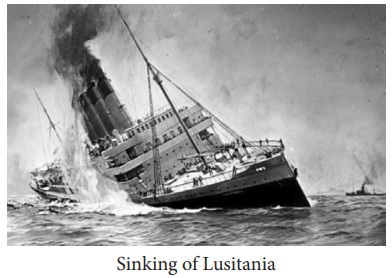
(c) The Armistice and Treaty of Versailles
Germany
ultimately surrendered in November 1918. The armistice took effect from 11
November 1918. Germany was forced to accept harsh terms by the political
situation at home with the abdication of the Kaiser William II.
Peace Conference in Paris
The Peace
Conference opened in Paris in January 1919, two months after the signing of the
armistice. Woodrow Wilson (USA), Lloyd George (Prime Minister of England) and
Clemenceau (Prime Minister of France) played a very important part in the
deliberations.

Faced
with a threat of a renewed war, the German government was forced to agree to
the terms. On 28 June, 1919 the peace treaty was signed in the Hall of Mirrors
at Versailles.
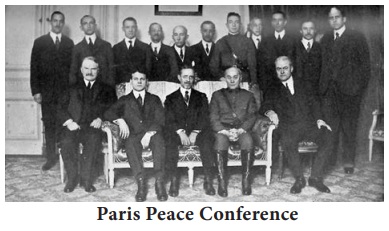
Provisions of the Treaty
1. Germany was found guilty of starting the War and
therefore was to pay reparations for the losses suffered. All Central Powers
were directed to pay war indemnity.
2. The German army was to be limited to 100,000
men. A small navy was allowed.
3. The union of Austria and Germany was forbidden.
4. All German colonies became mandated territories
under the League of Nations.
5. Germany was forced to revoke the Treaty of
Brest-Litovsk (with Russia) and Bucharest (Bulgaria).
6. Alsace–Lorraine was returned to France.
7. The former Russian territories of Finland,
Estonia, Latvia and Lithuania were to be independent
8. Northern Schleswig was given to Denmark and some
small districts to Belgium.
9. Poland was recreated.
10. The
Rhineland was to be occupied by the Allies. The area on the east bank of the
Rhine was to be demilitarized.
President Wilson laid down his Fourteen Points, which were to be
followed by the Allies. The most important one he highlighted was the need for
‘a general association of nations for the purpose of affording mutual
guarantees of political independence and territorial integrity to great and
small states like’.
Separate
treaties were drawn up and signed by the Allies with Austria, Hungary, Bulgaria
and Turkey. T e Treaty with Turkey (Treaty of Sevres), though accepted by the
Sultan, failed because of the resistance of Mustafa Kemal Pasha and his
followers.
Fallout of the First World War
The First
World War left a deep impact on European society and polity. Through
conscription, and through air raids, the War had involved and affected far more
of the population than in the past. 8 million had died in four years, while
more than twice as many were wounded, and many crippled for life. Millions more
had succumbed to the worldwide influenza of 1918. The outcome, in all
countries, was imbalance between the sexes—a shortage of men. Soldiers came to
be placed above civilians.
The War
and its aftermath turned out to be a stirring period of history. The most
striking of all was the rise and consolidation of the Soviet Union, the U.S.S.R
or the Union of Socialist and Soviet Republics, as it was called. America
entered the War as a debtor country but it emerged as the money-lender to the
world in the aftermath of the War.
Another
outstanding event of this period was the awakening of the colonies and their
inspired attempts to gain freedom.
Mustafa
Kemal Pasha played a remarkable role for Turkey’s rebirth as a nation. Kemal
Pasha modernised Turkey and changed it out of all recognition.
Impact on India
The First
World War had a significant impact on India. The British recruited a vast
contingent of Indians to serve in Europe, Africa and West Asia. After the War,
the soldiers came back with new ideas which had an impact on the Indian
society. India contributed £ 230 million in cash and over £ 125 million in
loans towards war expenses. India also sent war materials to the value £ 250
million. This caused enormous economic distress. There were grain riots as poor
people looted shops. Towards the end of the War India too suffered under the
world-wide epidemic of influenza. (£ - symbol of Pound sterling)
The War
conditions led to the rise of Home Rule Movement in India. The Congress was
reunited during the war.
India and
Indians had taken an active part in the War believing that Britain would reward
India's loyalty. But only disappointment was in store.Thus the War had multiple
effects on Indian society, economy and polity.
Related Topics